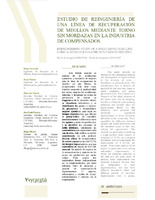Estudio de reingeniería de una línea de recuperación de meollos mediante torno sin mordazas en la industria de compensados
Reengineering study of a recovering core line using a spindleless lathe in plywood industry
Date
2017-11-01Author
Seewald, Diego Daniel
Peluso, Juan Ignacio
Marek, Marcelo Aurelio
Nucera, José Luis
Baeza, Diego
Metadata
Show full item recordAbstract
Este trabajo muestra un análisis de las condiciones operativas y desarrollo de mejoras para la línea de recuperación de meollos en una fábrica de compensados. Esto tiene como objetivo aumentar la productividad del sector, mejorar las condiciones laborales y disminuir los costos de producción. Se realizó un diagnóstico de la situación inicial, se obtuvieron indicadores y se identificaron los puntos a mejorar. Se propusieron y desarrollaron mejoras operativas para bajar los tiempos improductivos que afectan la productividad. Se cuantificó económicamente la diferencia entre los óptimos y reales de producción, y se identificó los causantes de dicha diferencia, valorizando las oportunidades que representan cada uno de ellos. Este análisis se realizó considerando un solo producto (lámina relleno de compensados). Se estimó una reducción del 21,3% los tiempos improductivos, con una oportunidad de mejora de $ 65.396 mensual. Se analizó el impacto de la automatización y mejoras en los costos de producción por metro cúbico. Cada mejora fue analizada en forma independiente en su implementación, por tener diferente valor de inversión y periodo de amortización. Se implementaron 11 mejoras, relacionadas a cambio de layout, automatización y mejoras en la organización. This paper presents an analysis of the operating conditions and development of improvements to the recovery of cores - byproducts in plywood plant. The manufacturer aims to increase the productivity and recovery, improve safety conditions and reduce production costs. Was carried out a diagnosis of the initial situation of the veneer lathe line, by sampling, in order to obtain the corresponding indicators and identify areas for improvement. Based on this diagnosis, were proposed and developed operational improvements to lower downtime identified in the veneer line. Were quantified the difference between optimal and actual production, and the identified cause of this was, valuing the opportunities. This analysis was performed considering a single product (inner veneer). A reduction of 21,3% was estimated downtime, with an opportunity for improvement of $ 65.396 per month. Were made analysis of the impact on production costs arising automation improvements, to obtain the estimated reduction in the total cost per cubic meter of product. Each improvement was analyzed separately because they are independent in their implementation, and also have different investment values and different periods of recovery. Improvements were 11 points, related to layout reform, new automatization and better organization.
URI
https://hdl.handle.net/20.500.12219/2657http://yvyrareta.com.ar/index.php/component/k2/item/50-est-reing-recu-meollos
Collections
- Revista Yvyraretá [351]
The following license files are associated with this item:




